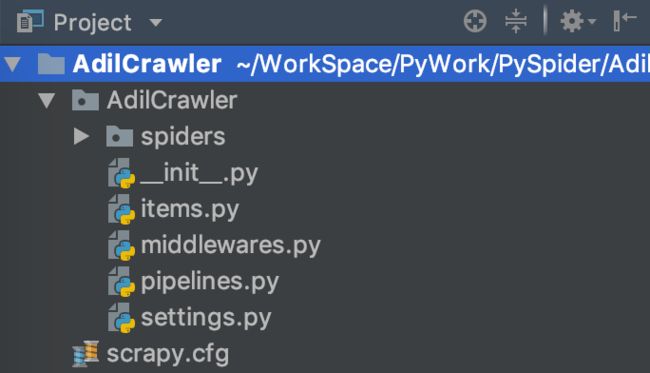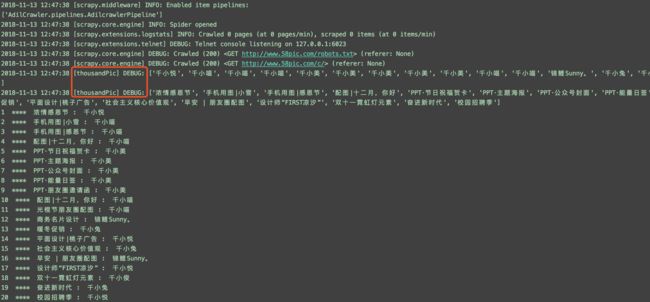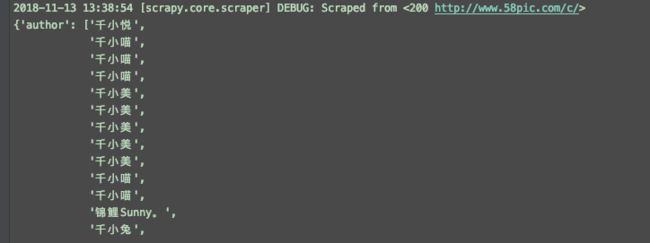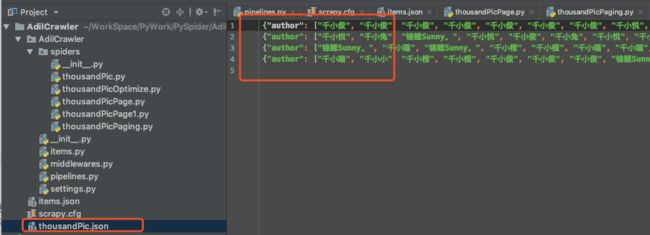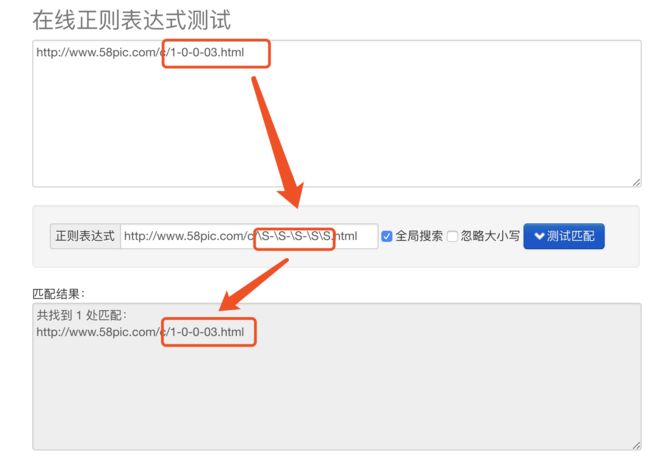之前有介绍 scrapy 的相关知识,但是没有介绍相关实例,在这里做个小例,供大家参考学习。
注:后续不强调python 版本,默认即为python3.x。
爬取目标
这里简单找一个图片网站,获取图片的先关信息。
该网站网址: http://www.58pic.com/c/
创建项目
终端命令行执行以下命令
scrapy startproject AdilCrawler
命令执行后,会生成如下结构的项目。
执行结果如下
如上图提示,cd 到项目下,可以执行 scrapy genspider example example.com 命令,创建 名为example,域名为example.com 的 爬虫文件。
编写items.py
这里先简单抓取图片的作者名称、图片主题等信息。
# -*- coding: utf-8 -*- # Define here the models for your scraped items # # See documentation in: # https://doc.scrapy.org/en/latest/topics/items.html import scrapy class AdilcrawlerItem(scrapy.Item): # define the fields for your item here like: # name = scrapy.Field() author = scrapy.Field() # 作者 theme = scrapy.Field() # 主题
编写spider文件
进入AdilCrawler目录,使用命令创建一个基础爬虫类:
scrapy genspider thousandPic www.58pic.com # thousandPic为爬虫名,www.58pic.com为爬虫作用范围
执行命令后会在spiders文件夹中创建一个thousandPic.py的文件,现在开始对其编写:
# -*- coding: utf-8 -*- import scrapy # 爬虫 小试 class ThousandpicSpider(scrapy.Spider): name = 'thousandPic' allowed_domains = ['www.58pic.com'] start_urls = ['http://www.58pic.com/c/'] def parse(self, response): ''' 查看页面元素 /html/body/div[4]/div[3]/div/a/p[2]/span/span[2]/text() 因为页面中 有多张图,而图是以 /html/body/div[4]/div[3]/div[i] 其中i 为变量 作为区分的 ,所以为了获取当前页面所有的图 这里 不写 i 程序会遍历 该 路径下的所有 图片。 '''# author 作者 # theme 主题 author = response.xpath('/html/body/div[4]/div[3]/div/a/p[2]/span/span[2]/text()').extract() theme = response.xpath('/html/body/div[4]/div[3]/div/a/p[1]/span[1]/text()').extract() # 使用 爬虫的log 方法在控制台输出爬取的内容。 self.log(author) self.log(theme) # 使用遍历的方式 打印出 爬取的内容,因为当前一页有20张图片。 for i in range(1, 21): print(i,' **** ',theme[i - 1], ': ',author[i - 1] )
执行命令,查看打印结果
scrapy crawl thousandPic
结果如下,其中DEBUG为 log 输出。
代码优化
引入 item AdilcrawlerItem
# -*- coding: utf-8 -*- import scrapy # 这里使用 import 或是 下面from 的方式都行,关键要看 当前项目在pycharm的打开方式,是否是作为一个项目打开的,建议使用这一种方式。 import AdilCrawler.items as items # 使用from 这种方式,AdilCrawler 需要作为一个项目打开。 # from AdilCrawler.items import AdilcrawlerItem class ThousandpicSpider(scrapy.Spider): name = 'thousandPic' allowed_domains = ['www.58pic.com'] start_urls = ['http://www.58pic.com/c/'] def parse(self, response): ''' 查看页面元素 /html/body/div[4]/div[3]/div/a/p[2]/span/span[2]/text() 因为页面中 有多张图,而图是以 /html/body/div[4]/div[3]/div[i] 其中i 为变量 作为区分的 ,所以为了获取当前页面所有的图 这里 不写 i 程序会遍历 该 路径下的所有 图片。 ''' item = items.AdilcrawlerItem() # author 作者 # theme 主题 author = response.xpath('/html/body/div[4]/div[3]/div/a/p[2]/span/span[2]/text()').extract() theme = response.xpath('/html/body/div[4]/div[3]/div/a/p[1]/span[1]/text()').extract() item['author'] = author item['theme'] = theme return item
scrapy crawl thousandPic -o items.json
会生成如图的文件
再次优化,使用 ItemLoader 功能类
使用itemLoader ,以取代杂乱的extract()和xpath()。
代码如下:
# -*- coding: utf-8 -*- import scrapy from AdilCrawler.items import AdilcrawlerItem # 导入 ItemLoader 功能类 from scrapy.loader import ItemLoader # optimize 优化 # 爬虫项目优化 class ThousandpicoptimizeSpider(scrapy.Spider): name = 'thousandPicOptimize' allowed_domains = ['www.58pic.com'] start_urls = ['http://www.58pic.com/c/'] def parse(self, response): ''' 查看页面元素 /html/body/div[4]/div[3]/div/a/p[2]/span/span[2]/text() 因为页面中 有多张图,而图是以 /html/body/div[4]/div[3]/div[i] 其中i 为变量 作为区分的 ,所以为了获取当前页面所有的图 这里 不写 i 程序会遍历 该 路径下的所有 图片。 ''' # 使用功能类 itemLoader,以取代 看起来杂乱的 extract() 和 xpath() ,优化如下 i = ItemLoader(item = AdilcrawlerItem(),response = response ) # author 作者 # theme 主题 i.add_xpath('author','/html/body/div[4]/div[3]/div/a/p[2]/span/span[2]/text()') i.add_xpath('theme','/html/body/div[4]/div[3]/div/a/p[1]/span[1]/text()') return i.load_item()
编写pipelines文件
默认pipelines.py 文件
# -*- coding: utf-8 -*- # Define your item pipelines here # # Don't forget to add your pipeline to the ITEM_PIPELINES setting # See: https://doc.scrapy.org/en/latest/topics/item-pipeline.html class Adilcrawler1Pipeline(object): def process_item(self, item, spider): return item
优化后代码如下
# -*- coding: utf-8 -*- # Define your item pipelines here # # Don't forget to add your pipeline to the ITEM_PIPELINES setting # See: https://doc.scrapy.org/en/latest/topics/item-pipeline.html import json class AdilcrawlerPipeline(object): ''' 保存item数据 ''' def __init__(self): self.filename = open('thousandPic.json','w') def process_item(self, item, spider): # ensure_ascii=False 可以解决 json 文件中 乱码的问题。 text = json.dumps(dict(item), ensure_ascii=False) + ',\n' # 这里是一个字典一个字典存储的,后面加个 ',\n' 以便分隔和换行。 self.filename.write(text) return item def close_spider(self,spider): self.filename.close()
settings文件设置
修改settings.py配置文件
找到pipelines 配置进行修改
# Configure item pipelines # See https://doc.scrapy.org/en/latest/topics/item-pipeline.html # ITEM_PIPELINES = { # 'AdilCrawler.pipelines.AdilcrawlerPipeline': 300, # } # 启动pipeline 必须将其加入到“ITEM_PIPLINES”的配置中 # 其中根目录是tutorial,pipelines是我的pipeline文件名,TutorialPipeline是类名 ITEM_PIPELINES = { 'AdilCrawler.pipelines.AdilcrawlerPipeline': 300, } # 加入后,相当于开启pipeline,此时在执行爬虫,会执行对应的pipelines下的类,并执行该类相关的方法,比如这里上面的保存数据功能。
执行命令
scrapy crawl thousandPicOptimize
执行后生成如下图文件及保存的数据
使用CrawlSpider类进行翻页抓取
使用crawl 模板创建一个 CrawlSpider
执行命令如下
scrapy genspider -t crawl thousandPicPaging www.58pic.com
items.py 文件不变,查看 爬虫 thousandPicPaging.py 文件
# -*- coding: utf-8 -*- import scrapy from scrapy.linkextractors import LinkExtractor from scrapy.spiders import CrawlSpider, Rule class ThousandpicpagingSpider(CrawlSpider): name = 'thousandPicPaging' allowed_domains = ['www.58pic.com'] start_urls = ['http://www.58pic.com/'] rules = ( Rule(LinkExtractor(allow=r'Items/'), callback='parse_item', follow=True), ) def parse_item(self, response): i = {} #i['domain_id'] = response.xpath('//input[@id="sid"]/@value').extract() #i['name'] = response.xpath('//div[@id="name"]').extract() #i['description'] = response.xpath('//div[@id="description"]').extract() return i
修改后如下
# -*- coding: utf-8 -*- import scrapy # 导入链接规则匹配类,用来提取符合规则的连接 from scrapy.linkextractors import LinkExtractor # 导入CrawlSpider类和Rule from scrapy.spiders import CrawlSpider, Rule import AdilCrawler.items as items class ThousandpicpagingSpider(CrawlSpider): name = 'thousandPicPaging' allowed_domains = ['www.58pic.com'] # 修改起始页地址 start_urls = ['http://www.58pic.com/c/'] # Response里链接的提取规则,返回的符合匹配规则的链接匹配对象的列表 # http://www.58pic.com/c/1-0-0-03.html 根据翻页连接地址,找到 相应的 正则表达式 1-0-0-03 -> \S-\S-\S-\S\S 而且 这里使用 allow # 不能使用 restrict_xpaths ,使用 他的话,正则将失效 page_link = LinkExtractor(allow='http://www.58pic.com/c/\S-\S-\S-\S\S.html', allow_domains='www.58pic.com') rules = ( # 获取这个列表里的链接,依次发送请求,并且继续跟进,调用指定回调函数处理 Rule(page_link, callback='parse_item', follow=True), # 注意这里的 ',' 要不会报错 ) # 加上这个 方法是为了 解决 parse_item() 不能抓取第一页数据的问题 parse_start_url 是 CrawlSpider() 类下的方法,这里重写一下即可 def parse_start_url(self, response): i = items.AdilcrawlerItem() author = response.xpath('/html/body/div[4]/div[3]/div/a/p[2]/span/span[2]/text()').extract() theme = response.xpath('/html/body/div[4]/div[3]/div/a/p[1]/span[1]/text()').extract() i['author'] = author i['theme'] = theme yield i # 指定的回调函数 def parse_item(self, response): i = items.AdilcrawlerItem() author = response.xpath('/html/body/div[4]/div[3]/div/a/p[2]/span/span[2]/text()').extract() theme = response.xpath('/html/body/div[4]/div[3]/div/a/p[1]/span[1]/text()').extract() i['author'] = author i['theme'] = theme yield i
再次执行
scrapy crawl thousandPicPaging
查看执行结果,可以看到是有4页的内容
再次优化引入 ItemLoader 类
# -*- coding: utf-8 -*- import scrapy # 导入链接规则匹配类,用来提取符合规则的连接 from scrapy.linkextractors import LinkExtractor # 导入CrawlSpider类和Rule from scrapy.loader import ItemLoader from scrapy.spiders import CrawlSpider, Rule import AdilCrawler.items as items class ThousandpicpagingopSpider(CrawlSpider): name = 'thousandPicPagingOp' allowed_domains = ['www.58pic.com'] # 修改起始页地址 start_urls = ['http://www.58pic.com/c/'] # Response里链接的提取规则,返回的符合匹配规则的链接匹配对象的列表 # http://www.58pic.com/c/1-0-0-03.html 根据翻页连接地址,找到 相应的 正则表达式 1-0-0-03 -> \S-\S-\S-\S\S 而且 这里使用 allow # 不能使用 restrict_xpaths ,使用 他的话,正则将失效 page_link = LinkExtractor(allow='http://www.58pic.com/c/\S-\S-\S-\S\S.html', allow_domains='www.58pic.com') rules = ( # 获取这个列表里的链接,依次发送请求,并且继续跟进,调用指定回调函数处理 Rule(page_link, callback='parse_item', follow=True), # 注意这里的 ',' 要不会报错 ) # 加上这个 方法是为了 解决 parse_item() 不能抓取第一页数据的问题 parse_start_url 是 CrawlSpider() 类下的方法,这里重写一下即可 def parse_start_url(self, response): i = ItemLoader(item = items.AdilcrawlerItem(),response = response ) i.add_xpath('author','/html/body/div[4]/div[3]/div/a/p[2]/span/span[2]/text()') i.add_xpath('theme','/html/body/div[4]/div[3]/div/a/p[1]/span[1]/text()') yield i.load_item() # 指定的回调函数 def parse_item(self, response): i = ItemLoader(item = items.AdilcrawlerItem(),response = response ) i.add_xpath('author','/html/body/div[4]/div[3]/div/a/p[2]/span/span[2]/text()') i.add_xpath('theme','/html/body/div[4]/div[3]/div/a/p[1]/span[1]/text()') yield i.load_item()
执行结果是一样的。
最后插播一条 在线正则表达式测试 工具的广告,地址: http://tool.oschina.net/regex/
应用如下
至此,简单完成了一个网站的简单信息的爬取。后面还会有其他内容的介绍~
如果你要觉得对你有用的话,请不要吝惜你打赏,这将是我无尽的动力,谢谢!
